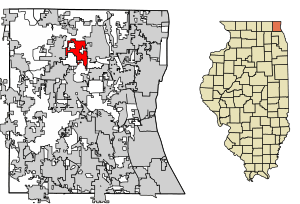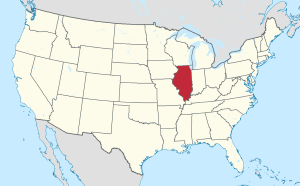Lindenhurst, Illinois facts for kids
Quick facts for kids
Lindenhurst, Illinois
|
|||
|---|---|---|---|
|
|||

Location of Lindenhurst in Lake County, Illinois.
|
|||

Location of Illinois in the United States
|
|||
| Country | United States | ||
| State | Illinois | ||
| County | Lake | ||
| Area | |||
| • Total | 4.86 sq mi (12.60 km2) | ||
| • Land | 4.53 sq mi (11.72 km2) | ||
| • Water | 0.34 sq mi (0.87 km2) | ||
| Population
(2020)
|
|||
| • Total | 14,406 | ||
| • Density | 3,182.24/sq mi (1,228.77/km2) | ||
| Time zone | UTC-6 (CST) | ||
| • Summer (DST) | UTC-5 (CDT) | ||
| ZIP Code(s) |
60046
|
||
| Area code(s) | 847 | ||
| FIPS code | 17-43770 | ||
| Home value: | $202,336 (2013) | ||
| Wikimedia Commons | Lindenhurst, Illinois | ||
Lindenhurst is a village located in Lake County, Illinois, United States. In 2020, about 14,406 people lived there. Lindenhurst is part of Lake Villa Township.
Contents
History of Lindenhurst
Lindenhurst is located in an area shaped by the last Ice Age, called the Valparaiso moraine. This land has many lakes and swamps. The Potawatomi Indian tribe first lived here, growing crops and also hunting and fishing. The rich soil later attracted European farmers.
In the 1830s, an expedition led by Colbee Benton explored the area. After this, the Potawatomi, Sauk, and Blackhawk Tribes agreed to leave the land. Most early European settlers came from the east coast. The first recorded settler was Noer Potter from Pennsylvania. Many Scottish, German, and English families also arrived early on.
Becoming a Village
Lindenhurst officially became a village on January 16, 1957. Papers to create the village were filed in November 1956. The first village leaders were chosen in December 1956, with almost everyone voting!
Lee R. Lewis was the first village president. Meetings were held on Saturdays so that people who worked far away could attend. The first meeting took place at the home of Helen Skelton, one of the trustees. Another election was held in April 1957, and Robert Randall became the new president. The village board held events like dances to raise money for things like stationery and record books. After his first year, President Randall was proud of their achievements. They had passed laws, set up zoning rules, fixed roads, removed snow, and started police patrols. Running water from a water tower arrived in the late 1950s.
Village Growth and Development
Building Homes in Lindenhurst
The village of Lindenhurst started on a large farm owned by Ernst E. Lehmann. This farm was bought by a developer named Morton "Mort" Engle. He named the area "Lindenhurst" because of the two rows of linden trees around the old farmhouse.
In 1952, Engle divided the 600-acre (2.4 km²) farm into smaller plots. The first homes were built in 1953. These homes cost about $12,000–$15,000 back then. A local historian, Joseph Brysiewicz, said that these homes were "the perfect solution for a home-hungry nation." By 1961, about 200 houses were being built each year. After building around 2,000 homes, Mort Engle sold his remaining land and moved away. More land was added to the village, and this growth led to new needs for schools and public safety.
Education in the Village
The first school in Lindenhurst was finished in September 1958. It was built on land from the Howard Bonner farm. The school was named B.J. Hooper School, after the school board president of Lake Villa District 41.
Local Businesses and Community Spaces
Lindenhurst's first business was Thor's Shell, a gas station. By 1960, the first big shopping area, Linden Plaza, was built. It had a bakery, a laundry, a dry cleaner, and a Piggly Wiggly grocery store. Other early businesses included a Texaco station, a barber shop, a Ben Franklin Variety Store, and a clothing store.
The Lindenhurst Civic Center built its own meeting place in 1961. It used parts of the old Lindenhurst Farm ice house. This center was used for many things, like meetings, parties, and even as a polling place for elections. The old school from the Lindenhurst farm served as the Village Hall until it burned down. The village offices then moved to Linden Plaza. By 1970, Lindenhurst had 3,141 people. A new village hall was built in 1974 to hold the growing village offices, police department, and other services.
Community Life and Events
In the 1980s, Lindenhurst got cable TV and fast food restaurants. The village budget grew to $1.5 million. In 1983, volunteers started Lindenfest. This festival began with tents and booths in the village hall parking lot. Today, it's a big event with a carnival, games, contests, races, and music. Other recent additions to Lindenhurst include Victory Lakes, the Lindenhurst-Lake Villa Chamber of Commerce, and the Lindenhurst Park District.
The population grew from 8,044 in 1990 to over 14,000 today. In 1999, the Village Administrator, James Stevens, said that Lindenhurst has kept its "small town flavor." This was done by carefully choosing where to expand and picking developers who built good quality homes. These homes, including single-family houses, townhomes, and condos, are mixed in with the village's lakes, marshes, open spaces, and forests. Lindenhurst's motto is "Developing Today for Tomorrow."
Geography of Lindenhurst
Lindenhurst is located at 42°24′37″N 88°1′34″W / 42.41028°N 88.02611°W.
According to the 2010 census, Lindenhurst covers about 4.774 square miles (12.36 km²). About 4.44 square miles (11.50 km²) of this is land, and 0.334 square miles (0.87 km²) is water.
Lindenhurst's first traffic light was put up at Grand Avenue and Sand Lake Road in the 1980s.
Main Streets

 Grand Avenue
Grand Avenue- Grass Lake Road
- Savage Road
- Gelden Road
- Deep Lake Road
- Granada Boulevard
- Sand Lake Road
- Beck Road
Population and Demographics
The population of Lindenhurst has grown quite a bit over the years:
| Historical population | |||
|---|---|---|---|
| Census | Pop. | %± | |
| 1960 | 1,259 | — | |
| 1970 | 3,141 | 149.5% | |
| 1980 | 6,220 | 98.0% | |
| 1990 | 8,038 | 29.2% | |
| 2000 | 12,539 | 56.0% | |
| 2010 | 14,462 | 15.3% | |
| 2020 | 14,406 | −0.4% | |
| U.S. Decennial Census 2010 2020 |
|||
Here's a look at the different groups of people living in Lindenhurst:
| Race / Ethnicity (NH = Non-Hispanic) | Pop 2010 | Pop 2020 | % 2010 | % 2020 |
|---|---|---|---|---|
| White alone (NH) | 12,182 | 11,044 | 84.23% | 76.66% |
| Black or African American alone (NH) | 332 | 391 | 2.30% | 2.71% |
| Native American or Alaska Native alone (NH) | 29 | 20 | 0.20% | 0.14% |
| Asian alone (NH) | 655 | 733 | 4.53% | 5.09% |
| Pacific Islander alone (NH) | 4 | 2 | 0.03% | 0.01% |
| Other race alone (NH) | 14 | 46 | 0.10% | 0.32% |
| Mixed race or Multiracial (NH) | 262 | 516 | 1.81% | 3.58% |
| Hispanic or Latino (any race) | 984 | 1,654 | 6.80% | 11.48% |
| Total | 14,462 | 14,406 | 100.00% | 100.00% |
See also
 In Spanish: Lindenhurst (Illinois) para niños
In Spanish: Lindenhurst (Illinois) para niños



